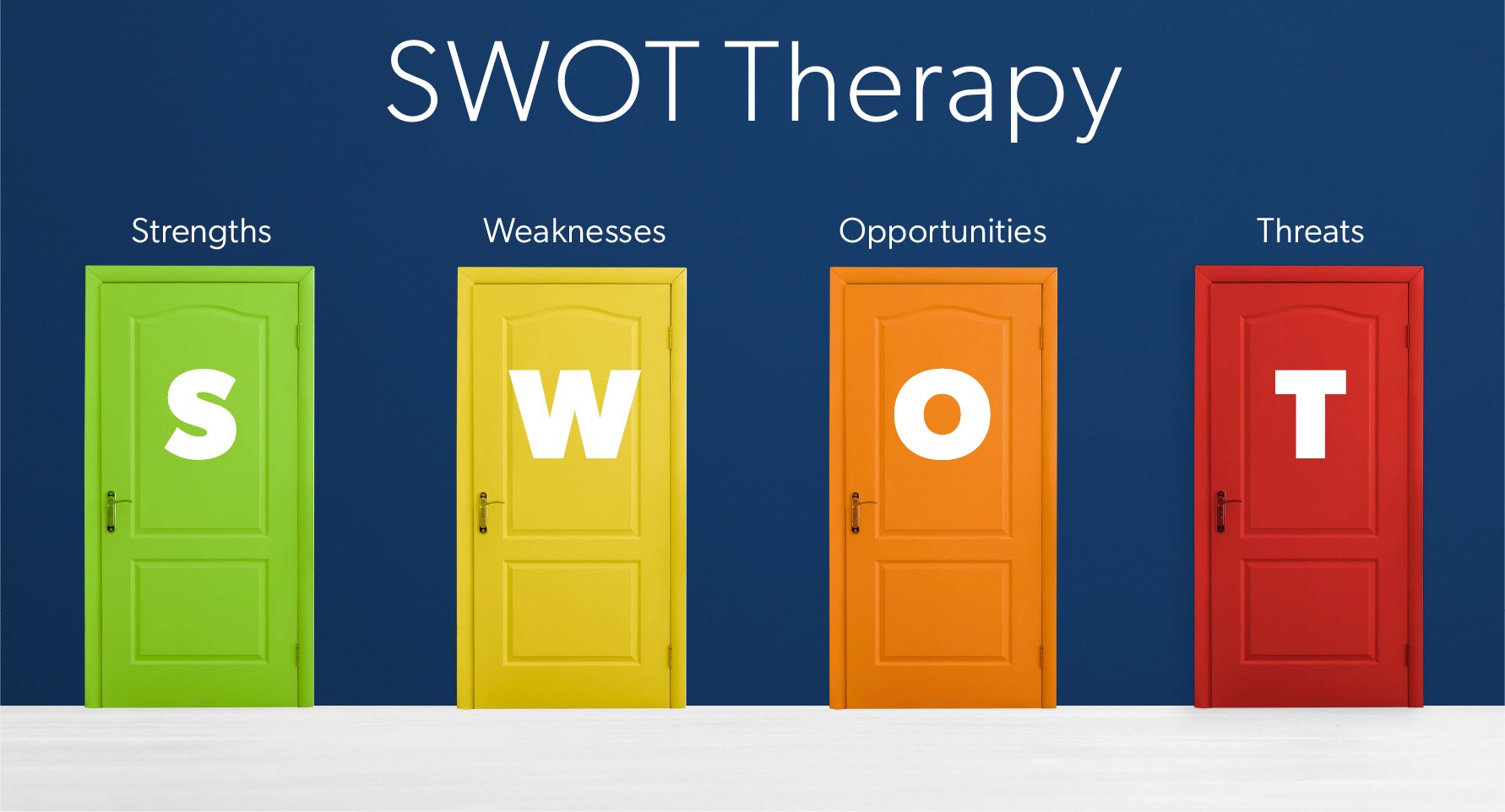SWOT Therapy: Strength training
Too often, companies treat the Strengths box like a victory lap—where the compliments go, where we congratulate ourselves. But that approach encourages you to NOT think about them very much: after all, they’re done!
Stay tuned…
Next, we'll delve into ironing out weaknesses effectively from our five-part SWOT Therapy series.
In our last piece, we made the case for conducting a SWOT at your organization and the positives that can come from it during your business planning. We maintain SWOTs should be approached as a strategic alignment tool that unifies stakeholders, clarifies focus, and unlocks real momentum.
They’re not just snapshots of “how we’re doing”: really good SWOTs lay the groundwork for the future of the business.
Now we’re zeroing in on the first quadrant of the SWOT matrix: Strengths.
In this conversation, Scot Safon and Robin McLoughlin unpack how they guide companies to treat Strengths not as a pat on the back, but as a strategic asset—one that drives storytelling, decision-making, operations, and growth.
Robin: One common pitfall we often observe post-SWOT analysis is the tendency for teams to mechanically list attributes that everyone agrees are ‘great things about our company.’ It’s the usual stuff they’re proud of—things management likes to say—but that’s where it stops. They just check them off and move on.
Scot: Yes—and it’s such a missed opportunity. “Strengths” just can’t be your feel-good list. After all, this list needs to inspire your business narratives, your decision-making filters, and your growth strategy.
Robin: Exactly. When we work with clients, we don’t just ask, “What are you good at?” We ask, “What’s actually driving value across your business—and how do we bring that to life in a way your team and your clients can feel to inspire future growth?”
Scot: Right. You have to drill down into each Strength. For example, I often see something like “our margins are great” listed as a Strength. But the Strength isn’t “great margins”…it’s why your margins are great. Is this because you have an internal culture of precision and proactive problem-solving?
And you need to “interrogate” each Strength too: is your pride about your great margins causing you to pull back on R&D, marketing investments, and longer-term growth strategies?
Maybe some of your short-term Strengths are masking some looming long-term Threats. That’s what a SWOT can help uncover—unpacking what a “true” Strength looks like.
Robin: Going deep on each proposed Strength is important—often we see groups identify legitimate Strengths without thinking through the true business advantages they represent.
Scot: Absolutely. I recently saw a SWOT that cited “Our Diversified Portfolio of Platforms” as a Strength. Digging a little deeper, it became clear that the Strength wasn’t the whole portfolio but two of the five platforms. But giving credit to the whole portfolio hid the fact that two of the five platforms were Weaknesses and one was an Opportunity.
Robin: That’s a great example, Scot. Think of this as the start of Phase Two of your SWOT. Once we’ve identified the real, tangible strengths—not vague positives—that’s when the team can really activate them.
Here are a few examples of turning our SWOT Strengths into action:
Generating Storytelling themes: For client pitches, recruitment, internal alignment
Identifying Strategic filters: What opportunities “play to your Strengths”...and which ones you walk away from
Reinforcing Operational KPIs: So you can measure and own your Strengths across departments
Differentiating your Customer experiences: Your Strengths don’t need to be “your secret”; let your market actually see your Strengths in action
Scot: One other thing: you need to resist the temptation to just do “all the Strengths” at the top of your SWOT exercise. You may list some immediate, evident ones… But be ready to circle back repeatedly to that list. You’ll add, subtract, or maybe shift some of those “strengths” to other categories. True “strengths” become a lot clearer as you dig into weaknesses, opportunities, and threats. It’s all connected, and your SWOT discussion needs to leave room for circling back, reconsidering, speculating…that’s really where the concepting and visioning start to happen.
Robin: Yes. For example, let’s say you’ve retained top-tier clients for 20 years. That’s a strength. But it’s also a signal: there’s likely an opportunity to turn that into a playbook for newer clients. And it’s a threat, too: What happens if one of those anchor clients leaves? Do you have a plan B?
Scot: Agree, finding the signal inside that Strength takes some work. I think we both enjoy it when leadership teams have those conversations—honest and open, beyond ‘legacy’ and divisional silos.
Robin: And then you get to the real benefit: making the Strengths section the foundation for the work ahead. But you only get there if the participants feel a sense of ownership. When my group is brought in, we often work with leadership to assign specific strengths to specific teams, then help them define what “owning it” looks like. That way, it’s not just a deck—it’s a playbook. It becomes actionable.
Scot: OK, we both maintain that Strengths are so much more than what your company is great at—they’re really why your company has a right to win. So the process of identifying and articulating Strengths ultimately allows you to grow smarter, align your teams, get a sharper plan together…and tell a better story. Because strong SWOTs aren’t about categories on a grid, they’re about insights, clarity, and action.
Coming Up Next:
Hello Weakness. My Old Friend.
They’re uncomfortable. They’re often political. And they’re usually the most misunderstood part of the SWOT matrix. But handled right? They’re also the key to transformation.
Connect with Scot and Robin:
Scot Safon, Marketing Consultant, Robin McLoughlin, Principal at McL
–––––––––––––––
Read more about brand strategy
SWOT Therapy: Every brand needs a little tough love

